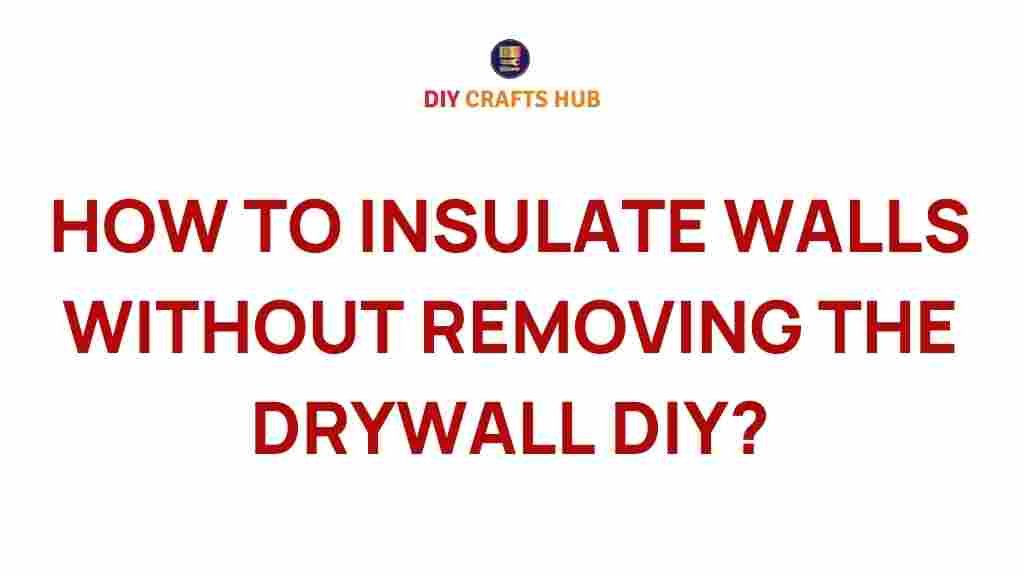

Discover How to Insulate Walls Without Removing Drywall
Enhancing your home’s energy efficiency doesn’t always mean tearing down walls. Whether you’re tackling high utility bills, battling uncomfortable indoor temperatures, or reducing noise levels, *insulating your walls without removing drywall* is a cost-effective and efficient solution. This guide will walk you through the process, ensuring you achieve a comfortable and energy-efficient home with minimal hassle.
Why Insulation Matters
Proper insulation is the backbone of a well-regulated home. It helps reduce energy consumption, lower heating and cooling costs, and create a cozy indoor environment. However, traditional insulation methods often involve removing drywall, which can be messy, time-consuming, and expensive. By choosing an alternative approach, you can reap the benefits of insulation while keeping disruptions to a minimum.
Benefits of Insulating Walls Without Removing Drywall
Here are some key advantages:
- Cost Savings: Avoid the expenses of drywall removal and replacement.
- Time Efficiency: Complete the project faster by skipping demolition.
- Less Mess: Keep your home cleaner with minimal debris.
- Energy Efficiency: Reduce heat loss and energy bills year-round.
Step-by-Step Guide to Insulating Walls Without Removing Drywall
1. Assess Your Walls
Before beginning, identify the walls that need insulation. Use a stud finder to locate wall studs and an inspection camera to check the current insulation level, if any. Understanding the wall’s construction is critical for a successful project.
2. Choose the Right Insulation Material
Not all insulation materials are suitable for retrofitting. Here are some popular choices:
- Blown-in Cellulose: Made from recycled paper, it’s eco-friendly and effective for retrofitting walls.
- Spray Foam: Provides excellent thermal resistance and air sealing but requires special equipment.
- Injection Foam: Ideal for small cavities and areas needing precise application.
Research the best insulation material for your specific needs and budget.
3. Prepare the Tools and Workspace
Gather the following tools:
- Drill and hole saw
- Blower or foam injection machine
- Protective gear (gloves, goggles, and a mask)
- Vacuum for cleaning dust
Clear the area near the walls to create a safe and accessible workspace.
4. Drill Access Holes
Using a drill with a hole saw, create small access holes between each stud, about 12 inches from the ceiling. Ensure the holes are large enough for the insulation hose or nozzle to fit through.
5. Install the Insulation
Follow these steps based on your chosen material:
- Blown-in Cellulose: Insert the hose into the access hole and fill the cavity evenly. Monitor for density to avoid overpacking.
- Spray Foam: Use the foam injection nozzle to fill the cavity. Be cautious to prevent excess expansion, which can damage walls.
- Injection Foam: Inject foam until the cavity is full. Ensure even distribution by moving the nozzle as needed.
6. Seal and Finish
After the insulation is installed, seal the access holes with plugs or patches. Smooth out the surface, then repaint or wallpaper to match the surrounding wall.
Troubleshooting Common Insulation Issues
Uneven Coverage
If some wall areas feel colder, you might have uneven insulation. Use an infrared thermometer to identify cold spots and reapply insulation if necessary.
Over-expansion of Spray Foam
Excess foam can cause bulging or cracking. Prevent this by applying foam in small increments and monitoring closely.
Settling Over Time
Blown-in insulation can settle, reducing its effectiveness. Consider topping it up after a few years to maintain optimal performance.
Moisture Issues
Ensure walls are dry before installing insulation. Moisture can lead to mold and reduce insulation efficiency. Use a moisture meter to check levels and address any leaks beforehand.
Additional Resources for Home Insulation
If you’re looking for more information, check out our detailed guide on home insulation. For professional help, consult certified insulation experts to ensure a successful project.
Conclusion
Insulating walls without removing drywall is an effective way to enhance your home’s comfort and energy efficiency. With the right tools, materials, and techniques, you can complete this project as a rewarding DIY endeavor. By following this guide, you’ll achieve lasting results without the hassle of demolition. Start today and enjoy the benefits of a well-insulated home!
This article is in the category DIY Tools and created by DIYCraft Team
Recent Posts
Uncovering the Secrets: Where Does the Bunny Hide? DIY Recipes Revealed
Discover where the bunny hides with our DIY recipes that bring festive treats to life…
Unlocking Space: The Art of DIY Murphy Bed Construction
Discover how to DIY a Murphy bed and transform your living space with this space-saving…
Mastering the Art of Ceiling Fan Balance: A DIY Guide
Discover how to balance a ceiling fan effortlessly with our DIY guide, ensuring energy efficiency…
Unveiling the Magic: Have You Seen This Wizard DIY Project?
Discover the wizard DIY project that transforms your space with enchanting decor and magical charm.
Master the Art of How to Get Rid of Fruit Flies: Simple DIY Solutions
Discover how to get rid of fruit flies with simple DIY solutions and natural repellents…
Unleashing the Joy: How to Make DIY Bubbles That Will Enchant Kids and Adults Alike
Discover how to make DIY bubbles with our simple guide. Uncover tips for creating the…